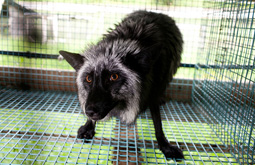The Red Fox / Silver Fox held in farms
Obviously, an animal used to such complex social behavior will not feel at ease in the desolate environment of an animal fur farm. The cages are normally 0,6 to a maximum of 2 m² in size and 60 to 75 cm high. For an animal used to occupying such a vast natural territory and able to lay back great distances, this cannot be described as species-appropriate. The cages worldwide are standardized, with mesh wire floors and a complete lack of structure. In some countries, there are recommendations to provide the foxes with lying platforms so that they can observe their environment. However, even if the cages were equipped with such platforms, they still consist of mesh wire, thus leading to injuries and deformations to the animals’ paws. Studies have shown that Red foxes prefer sand or torf floors. The monotonous and boring environment makes it impossible for them to behave naturally, so that they often walk back and forth endlessly in their cages.
The cubs are separated from their mother at eight weeks of age and from their siblings at 10 weeks of age. This is not in line with the animal’s biology either. They are then held individually or in pairs (male and female).
A nesting box is made available to vixens to give birth to their young. Otherwise, the foxes do not have the possibility to withdraw or hide. This leads to permanent stress for the frightened animals. Not only do the people on the farm scare them, the unnatural closeness to other foxes is an additional stress factor. The many rows of cages form a static social environment, so that the foxes, given their highly developed social behavior with strict hierarchies, are under permanent stress – unable to determine the distance to the other animals and unable to withdraw. This sometimes leads to the vixen lower in the social hierarchy killing their young. Sometimes, they maim their cubs before biting them to death. In addition to the closeness, the smell of the other animals and the excrements under the cages are further stress factors. For animals with such a pronounced sense of smell, used to react to odor markings, this is a cause for additional suffering.
Red foxes are afraid of human beings but are regularly removed from their cages (with pliers) for breeding, for their fur to be measured, for medicating, or for cages to be switched. The animals react to this with fear and panic. This tremendous stress factor could be reduced slightly by getting the animals accustomed to the proceedings. This, however, would require that the keepers spend time with the animals on a regular basis from the first minute on. For economic reasons, this is impossible and is not even the case on fur animal farms in fairly progressive countries.
Under permanent stress

CAUTION!
The following two films demonstrate hard facts and therefore may not be suited for everyone, in particular not the sensitive!
Fur farms – part 1
Fur farms – part 2
Additional information
-
The «Humane Society of the United States» and its Fur free campaign
The Canadian environmental protection organization «Global Action Network» and its extensive anti-fur campaign.
